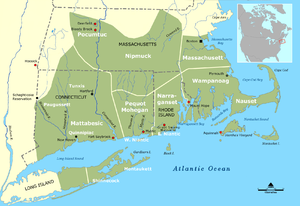Massachusett language
| Massachusett | |
|---|---|
|
Massachusett unnontꝏwaonk /wãpanaːãˈtuːaãk/ |
|
| Native to | United States |
| Region | Eastern Massachusetts , south-eastern New Hampshire , and northern and south-eastern Rhode Island . |
| Ethnicity | Massachusett, Wômpanâak (Wampanoag), Pawtucket (Naumkeag, Agawam), Nauset, and Coweset. Neighboring Algonquian peoples as a second language. |
| Extinct | Extinct late 19th century. |
| Revival | Revitalization from 1993. As of 2014, 5 children are native speakers, 15 are proficient second-language speakers and 500 are adult second-language learners. |
|
Algic
|
|
| Latin script | |
| Language codes | |
| ISO 639-3 | |
| Glottolog | wamp1249 |

The location of the Massachusett/Wampanoag tribe and their neighbors, c. 1600
|
|
Massachusett unnontꝏwaonk
/masatʃuːsət aːãtuːaãk/
The Massachusett language is an Algonquian language of the Algic language family, formerly spoken by several peoples of eastern coastal and south-eastern Massachusetts and currently, in its revived form, in four communities of Wampanoag people. The language is also known as Natick or Wôpanâak (Wampanoag) and historically as Pokanoket, Indian or Nonantum.
The language is most notable for creating a community of literate Indians and for the number of translations of religious texts into the language. John Eliot's translation of the Christian Bible in 1663 using the Natick dialect, known as Mamusse Wunneetupanatamwe Up-Biblum God, was the first printed in the Americas, the first Bible translated by a non-native speaker and one of the earliest example of a Bible translation into a previously unwritten language. Literacy spread quickly as Indian ministers and teachers, who were literate, spread literacy to the elites and other members of their communities. This is attested in the numerous court petitions, church records, Praying town administrative records, notes on book margins, personal letters and widespread distribution of other translations of religious tracts throughout the colonial period.
The dialects of the language were formerly spoken by several peoples of southern New England, including all the coastal and insular areas of eastern Massachusetts, as well as south-eastern New Hampshire, the southernmost tip of Maine and eastern Rhode Island, but was also a common second or third language across most of New England and portions of Long Island. The use of the language in the mixed-band communities of Christian converts—Praying towns— also spread the language to some groups of Nipmuc and Pennacook.
The revitalization of the language began in 1993 when Jessie Little Doe Baird (at the time with the last name Fermino) began the Wôpanâak Language Reclamation Project (WLRP), which has successfully re-introduced the revived Wampanoag dialect to the Aquinnah, Mashpee, Assonet and Herring Pond tribes of the Wampanoag of Cape Cod and the Islands, with a handful of children who are growing up as the first native speakers in more than a century. The Massachusett people continue to inhabit the area around Boston and other Wampanoag tribes are found throughout Cape Cod and Rhode Island. Other descendants of Massachusett-language speakers include many of the current Abenaki people and the locals of Saint David's Island, Bermuda, both of whom absorbed large numbers of Indians of southern New England in the aftermath of King Philip's War.
...
Wikipedia
